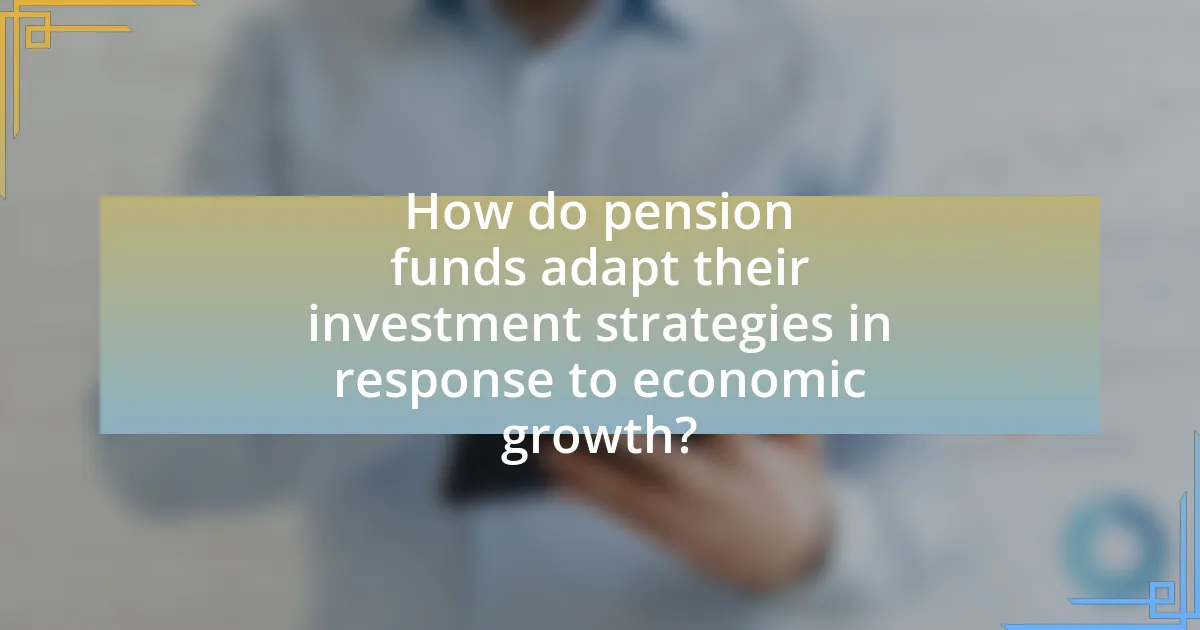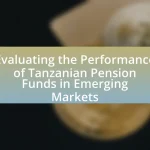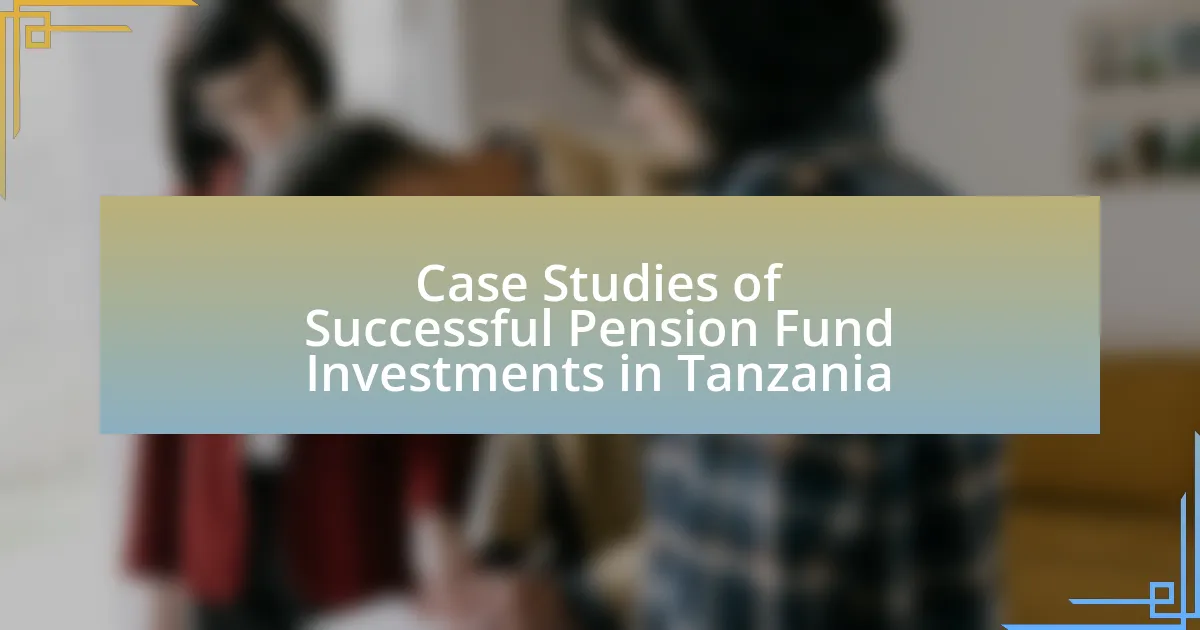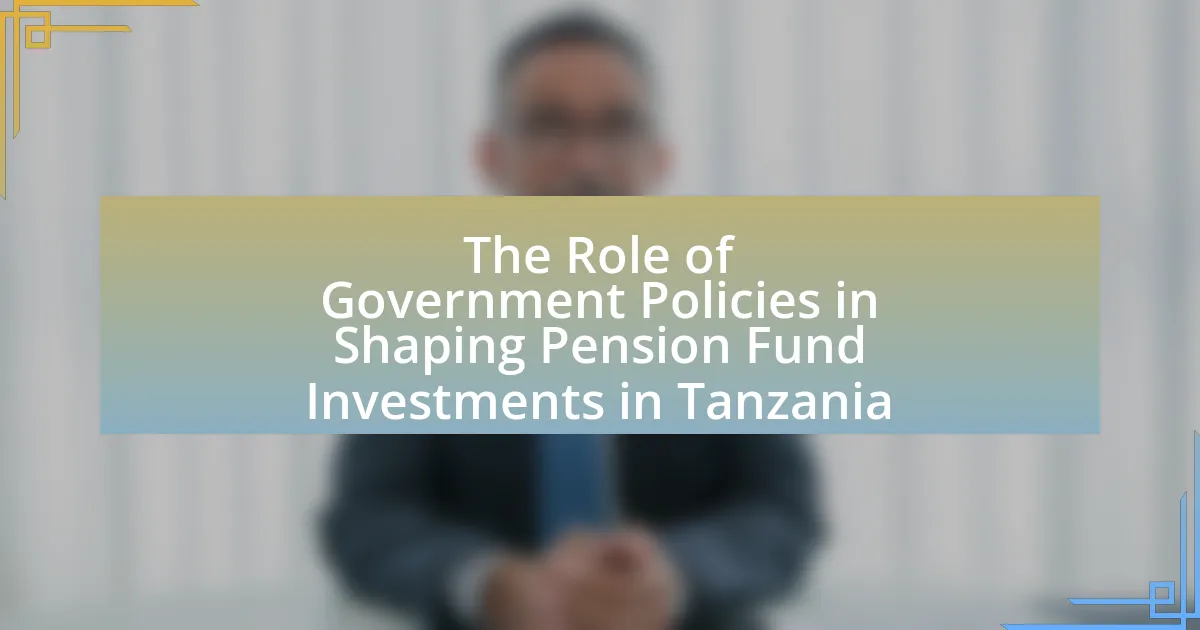The article examines the impact of Tanzania’s economic growth on pension fund investment strategies, highlighting how a growing GDP, which reached approximately 5.7% in 2022, creates new investment opportunities in sectors such as infrastructure, real estate, and equities. It discusses how economic indicators like GDP growth, inflation, and employment levels influence pension fund performance and investment decisions. Additionally, the article addresses the challenges pension funds face in a growing economy, including competition for assets and regulatory compliance, while outlining strategies for maximizing returns and ensuring long-term sustainability. The role of foreign investment and technology in enhancing pension fund strategies is also explored, emphasizing the importance of stakeholder engagement in shaping investment approaches.
What is the impact of Tanzania’s economic growth on pension fund investment strategies?
Tanzania’s economic growth positively influences pension fund investment strategies by increasing the availability of investment opportunities and enhancing the overall financial market environment. As Tanzania’s GDP has shown consistent growth, reaching approximately 5.7% in 2022, pension funds are encouraged to diversify their portfolios into sectors such as infrastructure, real estate, and equities, which are becoming more attractive due to improved economic stability and regulatory frameworks. This shift is supported by the government’s initiatives to foster a conducive investment climate, including the establishment of the Tanzania Investment Centre, which streamlines processes for foreign and domestic investors. Consequently, pension funds are adapting their strategies to capitalize on these emerging opportunities, aiming for higher returns while contributing to national development.
How does Tanzania’s economic growth influence pension fund performance?
Tanzania’s economic growth positively influences pension fund performance by increasing investment opportunities and enhancing returns. As the economy expands, sectors such as infrastructure, agriculture, and services experience growth, leading to higher profitability for businesses. This growth allows pension funds to invest in a broader range of assets, including equities and real estate, which typically yield higher returns. For instance, the World Bank reported that Tanzania’s GDP growth averaged around 6-7% annually over the past decade, creating a favorable environment for pension funds to achieve better performance through diversified investments.
What economic indicators are most relevant to pension funds in Tanzania?
The most relevant economic indicators for pension funds in Tanzania include GDP growth rate, inflation rate, interest rates, and employment levels. GDP growth rate is crucial as it reflects the overall economic health and potential for investment returns; for instance, Tanzania’s GDP growth has averaged around 6-7% in recent years, indicating a favorable environment for pension fund investments. The inflation rate affects the purchasing power of returns; Tanzania has experienced inflation rates averaging around 5%, which pension funds must consider to maintain real returns. Interest rates influence the cost of borrowing and the yield on fixed-income investments; the Bank of Tanzania’s monetary policy decisions directly impact these rates. Lastly, employment levels provide insights into economic stability and consumer spending, which are vital for assessing the long-term viability of investments.
How do changes in GDP affect pension fund investment decisions?
Changes in GDP significantly influence pension fund investment decisions by altering the economic environment in which these funds operate. When GDP rises, it typically indicates a growing economy, leading pension funds to invest more in equities and other growth-oriented assets due to increased confidence in market returns. Conversely, a decline in GDP often prompts pension funds to shift towards safer investments, such as bonds or cash equivalents, to mitigate risk during economic downturns. Historical data from the World Bank shows that during periods of GDP growth, such as the 2000s in Tanzania, pension funds increased their equity allocations, reflecting a bullish market sentiment. In contrast, during the global financial crisis of 2008, many pension funds reduced their equity exposure in response to falling GDP, highlighting the direct correlation between GDP fluctuations and investment strategies.
What are the key challenges faced by pension funds in a growing economy?
Pension funds face several key challenges in a growing economy, including increased competition for investment opportunities, inflationary pressures, and the need for diversification. As economies expand, the demand for high-quality assets rises, making it difficult for pension funds to secure attractive investments. Inflation can erode the purchasing power of pension payouts, necessitating strategies that ensure returns outpace inflation rates. Additionally, the need for diversification becomes critical as pension funds seek to mitigate risks associated with market volatility and economic fluctuations. These challenges require pension funds to adapt their investment strategies to maintain sustainable growth and meet their long-term obligations.
How does inflation impact pension fund investments in Tanzania?
Inflation negatively impacts pension fund investments in Tanzania by eroding the purchasing power of returns. As inflation rises, the real value of fixed-income investments, which are commonly held by pension funds, declines, leading to lower effective returns for retirees. For instance, if inflation is at 5% and a pension fund yields a nominal return of 6%, the real return is only 1%, which may not be sufficient to meet the future liabilities of pensioners. This situation necessitates pension funds to adjust their investment strategies, potentially increasing allocations to equities or inflation-linked assets to hedge against inflationary pressures.
What regulatory challenges do pension funds encounter during economic growth?
Pension funds encounter several regulatory challenges during economic growth, primarily related to compliance with evolving investment regulations and risk management requirements. As economies expand, regulatory bodies often introduce new rules aimed at ensuring financial stability, which can impose additional reporting and compliance burdens on pension funds. For instance, in Tanzania, the Pension Reform Act mandates that pension funds diversify their investment portfolios, which can complicate decision-making processes during periods of economic growth when opportunities may be rapidly changing. Furthermore, increased scrutiny from regulators regarding asset allocation and risk exposure can limit the flexibility of pension funds to capitalize on growth opportunities, potentially impacting their overall performance and ability to meet future liabilities.

How do pension funds adapt their investment strategies in response to economic growth?
Pension funds adapt their investment strategies in response to economic growth by reallocating assets towards higher-risk, higher-return investments such as equities and real estate. During periods of economic expansion, pension funds typically increase their exposure to growth-oriented sectors to capitalize on rising market valuations and improved corporate earnings. For instance, data from the World Bank indicates that in growing economies, pension funds often shift their portfolios to include a larger proportion of stocks, which historically outperform bonds in bullish markets. This strategic adjustment aims to enhance long-term returns and meet future liabilities more effectively.
What investment opportunities arise from Tanzania’s economic growth?
Tanzania’s economic growth presents several investment opportunities, particularly in sectors such as agriculture, infrastructure, and tourism. The country’s GDP growth rate has averaged around 6-7% over the past decade, driven by investments in these key sectors. For instance, the agricultural sector, which employs over 65% of the population, offers opportunities for agribusiness investments, especially in value-added processing and export-oriented production. Additionally, the government’s focus on infrastructure development, including roads, railways, and energy projects, creates avenues for public-private partnerships and investment in construction and energy sectors. The tourism industry, bolstered by Tanzania’s natural attractions like Serengeti National Park and Mount Kilimanjaro, also presents significant potential for investment in hospitality and related services, contributing to economic diversification and job creation.
Which sectors are most attractive for pension fund investments in Tanzania?
The most attractive sectors for pension fund investments in Tanzania are infrastructure, real estate, and agriculture. Infrastructure projects, such as roads and energy, are prioritized due to the government’s focus on economic development, with significant investments aimed at enhancing connectivity and energy supply. Real estate is appealing because of the growing urbanization and demand for housing, supported by a rising middle class. Agriculture remains a key sector, as it contributes significantly to the economy and offers opportunities for growth, particularly in value-added processing and export. These sectors are backed by government policies and initiatives aimed at fostering economic growth, making them viable options for pension fund investments.
How do pension funds assess risk in a growing economy?
Pension funds assess risk in a growing economy by analyzing economic indicators, market trends, and asset performance. They utilize quantitative models to evaluate potential returns against risks associated with various investment options, focusing on factors such as inflation rates, interest rates, and GDP growth. For instance, in a growing economy like Tanzania’s, pension funds may consider the rising consumer demand and increased corporate profitability, which can enhance investment opportunities. Additionally, they often conduct stress testing and scenario analysis to understand how different economic conditions could impact their portfolios, ensuring they are prepared for potential downturns. This systematic approach allows pension funds to make informed decisions that align with their long-term investment strategies while managing risk effectively.
What strategies do pension funds employ to maximize returns during economic expansion?
Pension funds employ several strategies to maximize returns during economic expansion, including increasing allocations to equities, diversifying into alternative investments, and leveraging economic growth sectors. By increasing equity exposure, pension funds capitalize on rising stock prices, which historically outperform other asset classes during economic upswings. For instance, during the economic expansion from 2009 to 2020, U.S. equity markets saw significant gains, prompting pension funds to enhance their equity allocations to capture these returns.
Additionally, pension funds diversify into alternative investments such as real estate, private equity, and infrastructure, which can provide higher returns compared to traditional fixed-income investments. This strategy allows funds to benefit from the growth in various sectors that thrive during economic booms. For example, the global private equity market has consistently delivered higher returns than public markets, particularly in periods of economic growth.
Furthermore, pension funds often focus on sectors that benefit directly from economic expansion, such as technology and consumer discretionary, to optimize their investment portfolios. By aligning their investment strategies with economic trends, pension funds can effectively enhance their overall returns during periods of growth.
How do diversification strategies change with economic growth?
Diversification strategies become more aggressive and varied with economic growth. As economies expand, investors often seek higher returns, leading to increased allocation in diverse asset classes such as equities, real estate, and alternative investments. For instance, during periods of robust economic growth, pension funds in Tanzania may shift from conservative investments like government bonds to more volatile assets that offer greater potential for capital appreciation. This shift is supported by historical data indicating that during economic upturns, equity markets tend to outperform fixed-income securities, prompting a reallocation of investment strategies to capitalize on growth opportunities.
What role does foreign investment play in pension fund strategies?
Foreign investment plays a crucial role in pension fund strategies by diversifying portfolios and enhancing returns. Pension funds allocate a portion of their assets to foreign investments to mitigate risks associated with domestic markets and to capitalize on growth opportunities in emerging economies. For instance, according to the World Bank, pension funds that invest internationally can achieve higher average returns, with studies indicating that global diversification can improve risk-adjusted performance by up to 1.5% annually. This strategic inclusion of foreign assets allows pension funds to better manage volatility and achieve long-term financial goals, particularly in the context of Tanzania’s economic growth, where expanding markets present significant investment potential.
What are the long-term implications of Tanzania’s economic growth on pension fund sustainability?
Tanzania’s economic growth has significant long-term implications for pension fund sustainability, primarily through increased contributions and investment opportunities. As the economy expands, higher employment rates and wage growth lead to increased contributions to pension funds, enhancing their financial stability. Additionally, a growing economy fosters a more diverse investment landscape, allowing pension funds to invest in various sectors, which can yield higher returns. For instance, Tanzania’s GDP growth rate averaged around 6-7% over the past decade, indicating a robust economic environment that supports pension fund growth. This economic trajectory can help ensure that pension funds remain solvent and capable of meeting future obligations to retirees.
How does economic growth affect the sustainability of pension funds?
Economic growth positively affects the sustainability of pension funds by increasing the overall investment returns and enhancing the funding status of these funds. When an economy grows, it typically leads to higher employment rates and wage growth, which in turn increases contributions to pension funds. For instance, in Tanzania, a growing economy can lead to improved financial markets, allowing pension funds to invest in a wider range of assets with potentially higher returns. Additionally, economic growth can result in increased consumer spending and business profits, which can further bolster the financial health of pension funds. Historical data from various economies shows that periods of robust economic growth correlate with improved pension fund performance, as seen in the rise of asset values and lower liabilities relative to assets.
What measures can pension funds take to ensure long-term viability?
Pension funds can ensure long-term viability by diversifying their investment portfolios across various asset classes, including equities, bonds, real estate, and alternative investments. This diversification reduces risk and enhances potential returns, which is crucial for meeting future liabilities. For instance, a study by the World Bank indicates that diversified portfolios can yield higher risk-adjusted returns, thereby improving the financial health of pension funds. Additionally, pension funds should adopt a robust risk management framework to monitor and mitigate investment risks effectively. Implementing regular asset-liability matching strategies can also help align investments with future payout obligations, ensuring that funds remain solvent over time.
How do demographic changes influence pension fund strategies in a growing economy?
Demographic changes significantly influence pension fund strategies in a growing economy by altering the age distribution of the population, which affects both the inflow of contributions and the outflow of benefits. As the population ages, pension funds may need to adjust their investment strategies to ensure sufficient liquidity for payouts to retirees while also seeking growth opportunities to meet long-term obligations. For instance, in Tanzania, the increasing proportion of working-age individuals can lead to higher contributions, allowing pension funds to invest more aggressively in growth-oriented assets. Conversely, a rising number of retirees necessitates a shift towards more conservative investments to safeguard capital and ensure that funds are available for benefit payments. This dynamic is supported by demographic data indicating that countries with a higher ratio of working-age individuals tend to experience stronger economic growth, which can enhance pension fund performance through increased investment returns.
What best practices can pension funds adopt in response to economic growth?
Pension funds can adopt diversification of investment portfolios as a best practice in response to economic growth. By spreading investments across various asset classes, such as equities, real estate, and infrastructure, pension funds can mitigate risks associated with market volatility while capitalizing on growth opportunities. For instance, during periods of economic expansion, equities typically perform well, providing higher returns, while real estate investments can offer stable income through rental yields. Historical data shows that diversified portfolios have outperformed concentrated investments, particularly in emerging markets like Tanzania, where economic growth can lead to increased market opportunities. This strategic approach allows pension funds to enhance their risk-adjusted returns while aligning with the dynamic economic landscape.
How can pension funds leverage technology to enhance investment strategies?
Pension funds can leverage technology to enhance investment strategies by utilizing advanced data analytics and artificial intelligence to improve decision-making processes. These technologies enable pension funds to analyze vast amounts of market data, identify trends, and optimize asset allocation. For instance, a study by McKinsey & Company found that firms using AI in investment management can achieve up to a 20% increase in returns by making more informed investment choices based on predictive analytics. Additionally, blockchain technology can enhance transparency and security in transactions, reducing operational risks and costs associated with managing pension assets.
What role does stakeholder engagement play in shaping investment strategies?
Stakeholder engagement is crucial in shaping investment strategies as it ensures that the interests and concerns of all relevant parties are considered. By actively involving stakeholders such as pension fund members, regulators, and investment managers, organizations can align their investment strategies with the expectations and needs of these groups. This alignment can lead to more sustainable and responsible investment decisions, ultimately enhancing the long-term performance of the funds. For instance, research indicates that pension funds that engage with stakeholders tend to adopt more environmentally and socially responsible investment practices, which can mitigate risks and improve returns.





